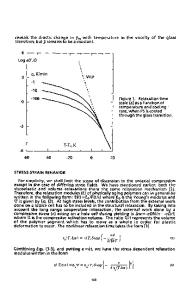Viscoelastic Relaxation in Glassy Polymers
- PDF / 266,745 Bytes
- 5 Pages / 420.48 x 639 pts Page_size
- 3 Downloads / 319 Views
VISCOELASTIC RELAXATION IN GLASSY POLYMERS T.S. CHOW Xerox Corporation, Webster Research Center, Webster, N.Y. 14580 ABSTRACT The nonequilibrium mechanism controlling the viscoelastic response in the glassy state is analyzed in accordance with our multiple hole energy model. The change in the nonequilibrium glassy state defines the Struik physical aging exponent and determines the motion of the relaxation time spectrum, the transition of the global shift factor and the slow decay of the stress relaxation modulus especially at longer times in the glassy state where the Kohlrausch-Williams-Watts function fails. Although the distribution of relaxation times has its time scales shifted with the aging time, the shape of the spectrum remains very much the same which supports the notion of thermo-aging-rheological simplicity in the glassy and transition states. INTRODUCTION Our statistical mechanical theory of the glass transition and relaxation [1] has been extended successfully in describing the equation of state for polymeric liquids and glasses [2] and the effect of physical aging on the yield behavior 13]. In this paper, the same underlying physics will be used to analyze the viscoelastic response in the glassy and glass transition regions. The subtle differences between the present theory and other related theoretical developments will be mentioned. MOLECULAR MODEL On the basis of our multiple hole energy model [11, both the equilibrium free volume fraction M and the nonequilibrium glassy state (8 = f-T) can be expressed in terms of the mean energy of hole (free volume) formation ('e), the shape of hole energy spectrum (p)and reference conditions. The equilibrium free volume fraction is described by -(T) = Irr exp [- E(T'-Tr'I)/R ] where T is temperature, R is the gas constant and the subscript r refers to the condition at T = Tr. While the glass transition temperature (T ) is a variable, the reference temperature is a fixed quantity which is found [4] to be linearly proportional to i-and near Tg. Differing from the conventional free volume concept, we have the nonlinear temperature dependence of free volume in the glassy state. When a system is cooled from equilibrium, the nonequilibrium state is determined by [2]
te S (T, te)
= -
f (q7-r/RT2) exp { [(te-t')/T ]/I dt'
(1)
0
where te is the aging time and q is the cooling (< o) rate. Here the global relaxation time , = rr exp {-[r(TTr) +(/p Mat. Res, Soc- Symp. Proc. Vol. 79
1987 Materials Research Society
2
}T-
r a(T, 8)
(2)
346
where ar = e-r/RTr 2 and a is the global shift factor. Many physical properties [1-31 have been quantitatively described by a single set of hole parameters: e-=
2.51 Kcal/mol,
/ =
0.48, T = 0.0336, Tr
(3)
= 25 min
for PVAc with [4] Tr = -/4.1R = 308K. In the rest of the paper, Eq. (3) will again be used in the study of the viscoelastic response of PVAc. RELAXATION SPECTRUM The fractional exponential decay of the shear modulus (G) was originally suggested by Kohlrausch [5]. The relaxation modulus can in general be written
Data Loading...











